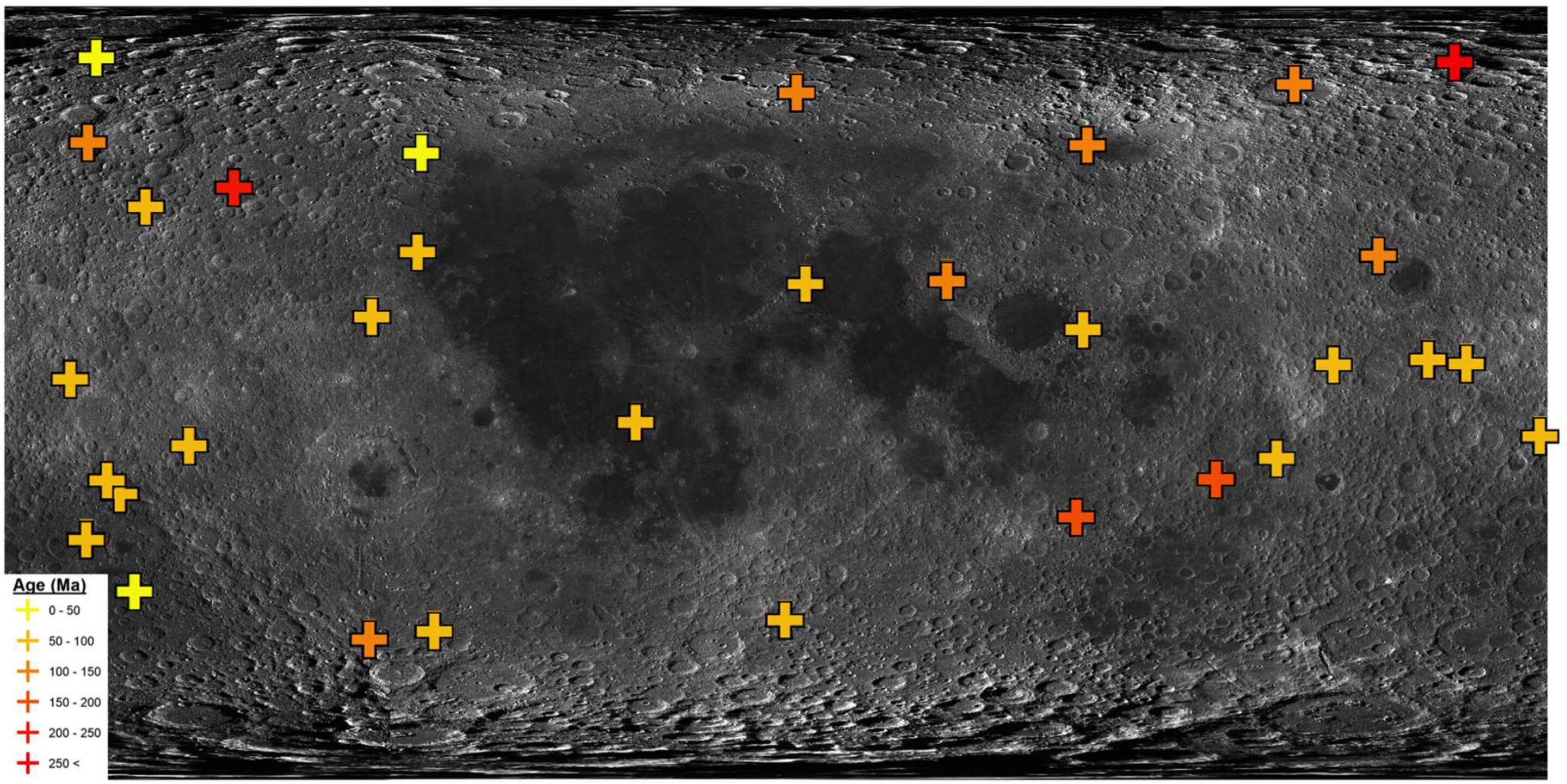
The moon’s steadfast illumination of our night sky has been a source of wonder and inspiration for millennia. Since the first satellite images of its surface were taken in the 1960s, our understanding of Earth’s companion through time has developed immeasurably. A complex interplay of cosmic interactions and planetary systems, the moon’s surface displays a plethora of landforms evidencing its history.
One such feature is lunar lobate scarps, long (<10 km) curvilinear landforms resulting from thrust fault movement, where older rocks are pushed above younger units leading to crustal shortening. These are thought to be some of the youngest landforms on the moon, forming within the last ~700 million years (the Copernican of the lunar geologic timescale). For context, this is considered geologically “young” as the universe is estimated to be 13.7 billion years old.
These lunar lobate scarps are the focus of new research, published in Earth and Planetary Science Letters, that use craters in the surrounding highland landscape as indicators of scarp movement and therefore are ideal candidates for estimating ages.
Explaining the significance of their research, Dr. Jaclyn Clark, of the University of Maryland, said, “Unlike Earth, the moon has no plate tectonics leading many scientists to explore what drives tectonism on the moon and other rocky bodies in our solar system.
“The existence of these small lobate thrust faults suggests that the lunar surface is contracting due to long-term interior cooling of the moon (cooling at a much faster rate than Earth).
“A better understanding of when tectonic activity has occurred and how the seismic energy attenuates through the regolith (unconsolidated rock and dust on top of bedrock) away from the fault by exploring the crater population could help plan safer missions to the moon.”
Using crater size-frequency distribution measurements, Dr. Clark and colleagues determined the ages of 34 lobate scarps on the moon’s surface. They further combined this with previous research to generate a dataset of 60 lobate scarps on both the near side and far side of the moon. Additionally, this data provided information on the magnitude of seismic activity associated with scarp movement and the likelihood of fault reactivation.
To do so, the scientists input high-resolution satellite images taken by the Lunar Reconnaissance Orbiter Camera into geological mapping software ArcGIS to measure the size and frequency of craters within a particular area, permitting calculation of cumulative crater density and an age model.
The research team observed a pattern in age distribution between footwalls (unit of rocks on the underside of a fault) and hanging walls (the unit above the fault thrust upwards) across craters, proximal and distal to the scarp. Proximally, ~38% of footwalls were younger than adjacent hanging walls, 47% the opposite and 15% approximately the same age. For distal scarps, 33% had hanging wall ages over twice that of proximal hanging walls, while distal footwalls were not often considerably older than their proximal counterparts.
Dr. Clark explains, “When we first started doing crater size-frequency distribution measurements at the proximal locations of the hanging wall and footwall, we initially saw that the hanging wall area produced a younger age than the footwall, leading us to think that there may be more seismic shaking in the hanging wall.
“After expanding this method to 34 scarps, we find that this is not the case for all of them. Many scarps have similar ages (i.e., ages that overlap within error) for the hanging walls and footwalls. Most differences in ages are between the proximal and distal locations, which is most likely due to the attenuation of seismic energy away from the fault.”
Consequently, this is evidence for reduced shaking from lobate scarp movement with distance, typically affecting the upper 1 km of the crust. This means seismic activity is constrained to shallower depths, increasing the intensity of shaking at the surface compared to if deeper in the crust; it is likely to have greater impact too as the moon’s weaker gravity makes it more susceptible to higher shaking intensity with small magnitude moonquakes.
Furthermore, the research team found a random distribution in lobate scarp ages spatially, with no particular area of the planetary body displaying a cluster of similar ages, as well as no clear correlation between age and scarp length. They did however find some correlation between scarp shape and age, with linear scarps forming over 250 million years and arcuate and irregular scarps over the last 50–150 million years.
Therefore, this suggests scarp formation is due to a combination of the cooling of the moon’s interior over millions of years, resulting in global contraction (generating arcuate and irregular scarps) and diurnal tidal stresses (linear scarps).
Most of the thrust fault activity associated with lobate scarp formation was dated to the last 400 million years, the most recent being 24 million years ago. Interestingly, the scientists also noticed a declining trend in the size of craters being impacted by scarp movements within the last 250 million years, therefore suggesting that there has also been a decrease in moonquake activity during this time. Dr. Clark notes that “it could mean the rate of interior cooling is slowing down” but that more research is required to determine if this trend will continue.
Overall, scarp movement encourages the formation of new craters, resurfacing the moon’s landscape and generating younger ages for its landforms. The impact of this resetting of crater chronologies on our understanding of lunar processes is something the scientists are keen to explore further, as Dr. Clark explains, “With no atmosphere on the moon, processes like tectonism and volcanism have been largely changing the lunar surface.
“With the limited number of samples from the moon, crater size-frequency distribution measurements are currently our best option for ascertaining surface ages. In addition to getting a resurface age, exploring the crater size range may provide insights into how craters degrade in certain materials or processes. This work has only just scratched the surface and we’re looking forward to expanding on this research in the future.” https://phys.org/news/2024-04-lunar-landforms-geologically-seismic-moon.html







Recent Comments